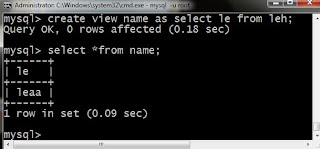Brief discussion about the history of SQL
SQL
original name was “Structured English Query Language” or SEQUEL,
developed by IBM around 1975, and then became SEQUEL/2 then SQL.
Simple/Basic query used in SQL are Select, Project and Join
SQL
Select – the select statement used for retrieval queries in SQL. Basic SQL
select is the SELECT –FROM-WHERE block
Example: Let’s say we have a company database with a table
employee, under this table are Fname, Minit, Lname, SSN, Bdate, Address . Inside
the table is a record of employee named Franklin T. Wong, and we want to
retrieve it Birthdate and address we can use this syntax:
SELECT BDATE, ADDRESS
FROM EMPLOYEE
WHERE FNAME='Franklin' AND MINIT='T’
AND
LNAME='Wong’;
Using ALIASES :
The use of aliases allows some queries who need to refer to the same relation twice. Aliases will handle the relation name.
Example: Let us again use the company database. with additional attributes like
salary, superssn,dno. Now retrieve the employee's name and the name of his or her immediate supervisor.
SELECT E.FNAME, E.LNAME, S.FNAME, S.LNAME
FROM EMPLOYEE AS
E, EMPLOYEE AS S
WHERE E.SUPERSSN=S.SSN;
No Where -clause
Disregarding the use of where clause means there is no condition under the given query, all the relations inside the FROM-clause where selected. unused WHERE-clause means WHERE TRUE.
Example: On the company database lets retrieve the fname of the table employee without using specifying the fname to include in the retrieval.
SELECT FNAME
FROM EMPLOYEE;
USE * :
When we use * means we are selecting all attributes of a given table.
Example: On the company database, let us retrieve all the attribute of the table employee having a specific DNO lets say DNO=4.
SELECT *
FROM EMPLOYEE
WHERE DNO=4;
USE of DISTINCT
In SQL it treat relation as a set. In some cases many tuples are being duplicated , in order to eliminate this and use or retrieve only those relation once with a duplicate or not we use the keyword DISTINCT.
Example: In database company lets first print out or retrieve the salary of employee as the usual kind of retrieving: "select salary from employee;"
---------- you can see on the print that the salary being printed that some has duplicate.
now to eliminate this let us use DISTINCT
SELECT SALARY
FROM DISTINCT EMPLOYEE;
USE OF OPERATIONS :
Some of SQL operations are UNION, set DIFFERENCE or MINUS and Intersection (INTERSECT). In using this operations there are some exception that need to remember. The two relations must have the same attributes and the attributes must appear in the same order.
Example: Printout all the project numbers that involve an employee whose last name is 'Smith' worker or manager of a department that controls the project.
SYNTAX:
SELECT PNAME
FROM PROJECT, DEPARTMENT, EMPLOYEE
WHERE DNUM=DNUMBER and MGRSSN=SSN
AND LNAME='Smith'
UNION (SELECT PNAME
FROM PROJECT,WORKS_ON, EMPLOYEE
WHERE PNUMBER=PNO AND ESSN=SSN AND LNAME='SMITH');
NESTED QUERIES:
Nested queries is a complete SELECT query, nested queries can be specified within the WHERE-clause of another query which we called outer query
CORRELATED QUERY
The result of a correlated nested query is different for each tuple (or combination of
tuples) of the relation(s) the outer query
EXISTS CLAUSE
The exist clause is used in checking correlated nested query is empty or not
EXPLICIT SETS
Using an set of values in where clause rather than in nested query
NULL
It is allowed in SQL query to check of the values where null
JOIN RELATIONS
Under the WHERE clause join relation can be used. Join in mysql means query data from two or more tables.
AGGREGATE FUNCTIONS
It allows or let you you to return a single value after the performing a calculation on a set of records
GROUPING
GROUP BY-clause is used in grouping attributes. It can be used in aggregate functions and also in SELECT-clause

































